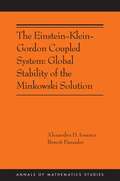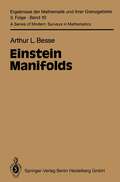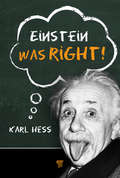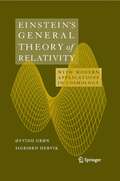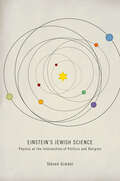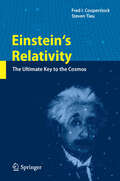- Table View
- List View
Einstein Equations: Domoschool 2019 (Tutorials, Schools, and Workshops in the Mathematical Sciences)
by Sergio Luigi Cacciatori Alexander KamenshchikThis volume guides early-career researchers through recent breakthroughs in mathematics and physics as related to general relativity. Chapters are based on courses and lectures given at the July 2019 Domoschool, International Alpine School in Mathematics and Physics, held in Domodossola, Italy, which was titled “Einstein Equations: Physical and Mathematical Aspects of General Relativity”. Structured in two parts, the first features four courses from prominent experts on topics such as local energy in general relativity, geometry and analysis in black hole spacetimes, and antimatter gravity. The second part features a variety of papers based on talks given at the summer school, including topics like:Quantum ergosphereGeneral relativistic Poynting-Robertson effect modellingNumerical relativityLength-contraction in curved spacetimeClassicality from an inhomogeneous universeEinstein Equations: Local Energy, Self-Force, and Fields in General Relativity will be a valuable resource for students and researchers in mathematics and physicists interested in exploring how their disciplines connect to general relativity.
The Einstein Equations and the Large Scale Behavior of Gravitational Fields: 50 Years of the Cauchy Problem in General Relativity
by Piotr T. Chrusciel Helmut FriedrichThe book presents state-of-the-art results on the analysis of the Einstein equations and the large scale structure of their solutions. It combines in a unique way introductory chapters and surveys of various aspects of the analysis of the Einstein equations in the large. It discusses applications of the Einstein equations in geometrical studies and the physical interpretation of their solutions. Open problems concerning analytical and numerical aspects of the Einstein equations are pointed out. Background material on techniques in PDE theory, differential geometry, and causal theory is provided.
Einstein in Matrix Form: Exact Derivation of the Theory of Special and General Relativity without Tensors (Graduate Texts in Physics)
by Günter LudykThis book is an introduction to the theories of Special and General Relativity. The target audience are physicists, engineers and applied scientists who are looking for an understandable introduction to the topic - without too much new mathematics. The fundamental equations of Einstein's theory of Special and General Relativity are derived using matrix calculus, without the help of tensors. This feature makes the book special and a valuable tool for scientists and engineers with no experience in the field of tensor calculus. In part I the foundations of Special Relativity are developed, part II describes the structure and principle of General Relativity. Part III explains the Schwarzschild solution of spherical body gravity and examines the "Black Hole" phenomenon. Any necessary mathematical tools are user friendly provided, either directly in the text or in the appendices.
The Einstein-Klein-Gordon Coupled System: Global Stability of the Minkowski Solution: (AMS-213) (Annals of Mathematics Studies #406)
by Alexandru D. Ionescu Benoît PausaderA definitive proof of global nonlinear stability of Minkowski space-time as a solution of the Einstein-Klein-Gordon equationsThis book provides a definitive proof of global nonlinear stability of Minkowski space-time as a solution of the Einstein-Klein-Gordon equations of general relativity. Along the way, a novel robust analytical framework is developed, which extends to more general matter models. Alexandru Ionescu and Benoît Pausader prove global regularity at an appropriate level of generality of the initial data, and then prove several important asymptotic properties of the resulting space-time, such as future geodesic completeness, peeling estimates of the Riemann curvature tensor, conservation laws for the ADM tensor, and Bondi energy identities and inequalities.The book is self-contained, providing complete proofs and precise statements, which develop a refined theory for solutions of quasilinear Klein-Gordon and wave equations, including novel linear and bilinear estimates. Only mild decay assumptions are made on the scalar field and the initial metric is allowed to have nonisotropic decay consistent with the positive mass theorem. The framework incorporates analysis both in physical and Fourier space, and is compatible with previous results on other physical models such as water waves and plasma physics.
Einstein Manifolds (Classics In Mathematics Ser.)
by Arthur L. BesseEinstein's equations stem from General Relativity. In the context of Riemannian manifolds, an independent mathematical theory has developed around them. This is the first book which presents an overview of several striking results ensuing from the examination of Einstein’s equations in the context of Riemannian manifolds. Parts of the text can be used as an introduction to modern Riemannian geometry through topics like homogeneous spaces, submersions, or Riemannian functionals.
The Einstein, Podolsky, and Rosen Paradox in Atomic, Nuclear, and Particle Physics
by Alexander Afriat F. Selleri"Paradox" conjures up arrows and tortoises. But it has a speculative, gedanken ring: no one would dream of really conjuring up Achilles to confirm that he catches the tortoise. The paradox of Einstein, Podolsky, and Rosen, however, is capable of empirical test. Attempted experimental resolutions have involved photons, but these are not detected often enough to settle the matter. Kaons are easier to detect and will soon be used to discriminate between quantum mechanics and local realism. The existence ofan objective physical reality,which had disappeared behind the impressive formalism of quantum mechanics, was originally intended to be the central issue of the paradox; locality, like the mathematics used, was just assumed to hold. Quantum mechanics, with its incompatible measurements, was born rather by chance in an atmosphere of great positivistic zeal, in which only the obviously measurable had scientific respectability. Speculation about occult "unobservable" quantities was viewed as vacuous metaphysics, which should surely form no part of a mature scientific attitude. Soon the "unmeasurable, " once only disreputable, vanished altogether. One had first been told not to worry about it; then, as dogma got more carefully defined, one was assured that the unobserved was just not there. This made it easier not to think about it and to avoid hazardous metaphysical temptation.
Einstein Was Right!
by Karl HessAll modern books on Einstein emphasize the genius of his relativity theory and the corresponding corrections and extensions of the ancient space-time concept. However, Einstein's opposition to the use of probability in the laws of nature and particularly in the laws of quantum mechanics is criticized and often portrayed as outdated. The author of E
Einstein’s Field Equations and Their Physical Implications: Selected Essays in Honour of Jürgen Ehlers (Lecture Notes in Physics #540)
by Bernd G. SchmidtThis book serves two purposes. The authors present important aspects of modern research on the mathematical structure of Einstein's field equations and they show how to extract their physical content from them by mathematically exact methods. The essays are devoted to exact solutions and to the Cauchy problem of the field equations as well as to post-Newtonian approximations that have direct physical implications. Further topics concern quantum gravity and optics in gravitational fields.The book addresses researchers in relativity and differential geometry but can also be used as additional reading material for graduate students.
Einstein's General Theory of Relativity: With Modern Applications in Cosmology
by Øyvind Grøn Sigbjorn HervikThis book introduces the general theory of relativity and includes applications to cosmology. The book provides a thorough introduction to tensor calculus and curved manifolds. After the necessary mathematical tools are introduced, the authors offer a thorough presentation of the theory of relativity. Also included are some advanced topics not previously covered by textbooks, including Kaluza-Klein theory, Israel's formalism and branes. Anisotropic cosmological models are also included. The book contains a large number of new exercises and examples, each with separate headings. The reader will benefit from an updated introduction to general relativity including the most recent developments in cosmology.
Einstein's Jewish Science: Physics at the Intersection of Politics and Religion
by Steven GimbelIs relativity Jewish? The Nazis denigrated Albert Einstein’s revolutionary theory by calling it "Jewish science," a charge typical of the ideological excesses of Hitler and his followers. Philosopher of science Steven Gimbel explores the many meanings of this provocative phrase and considers whether there is any sense in which Einstein’s theory of relativity is Jewish. Arguing that we must take seriously the possibility that the Nazis were in some measure correct, Gimbel examines Einstein and his work to explore how beliefs, background, and environment may—or may not—have influenced the work of the scientist. You cannot understand Einstein’s science, Gimbel declares, without knowing the history, religion, and philosophy that influenced it. No one, especially Einstein himself, denies Einstein's Jewish heritage, but many are uncomfortable saying that he was being a Jew while he was at his desk working. To understand what "Jewish" means for Einstein’s work, Gimbel first explores the many definitions of "Jewish" and asks whether there are elements of Talmudic thinking apparent in Einstein’s theory of relativity. He applies this line of inquiry to other scientists, including Isaac Newton, René Descartes, Sigmund Freud, and Émile Durkheim, to consider whether their specific religious beliefs or backgrounds manifested in their scientific endeavors. Einstein's Jewish Science intertwines science, history, philosophy, theology, and politics in fresh and fascinating ways to solve the multifaceted riddle of what religion means—and what it means to science. There are some senses, Gimbel claims, in which Jews can find a special connection to E = mc2, and this claim leads to the engaging, spirited debate at the heart of this book.
Einstein's Miraculous Year: Five Papers That Changed the Face of Physics
by Albert EinsteinFive extraordinary papers by Albert Einstein that transformed physics, edited and introduced by John Stachel and with a foreword by Nobel laureate Roger Penrose After 1905, Einstein's miraculous year, physics would never be the same again. In those twelve months, Einstein shattered many cherished scientific beliefs with five extraordinary papers that would establish him as the world's leading physicist. This book brings those papers together in an accessible format. The best-known papers are the two that founded special relativity: On the Electrodynamics of Moving Bodies and Does the Inertia of a Body Depend on Its Energy Content? In the former, Einstein showed that absolute time had to be replaced by a new absolute: the speed of light. In the second, he asserted the equivalence of mass and energy, which would lead to the famous formula E = mc2.The book also includes On a Heuristic Point of View Concerning the Production and Transformation of Light, in which Einstein challenged the wave theory of light, suggesting that light could also be regarded as a collection of particles. This helped to open the door to a whole new world—that of quantum physics. For ideas in this paper, he won the Nobel Prize in 1921.The fourth paper also led to a Nobel Prize, although for another scientist, Jean Perrin. On the Movement of Small Particles Suspended in Stationary Liquids Required by the Molecular-Kinetic Theory of Heat concerns the Brownian motion of such particles. With profound insight, Einstein blended ideas from kinetic theory and classical hydrodynamics to derive an equation for the mean free path of such particles as a function of the time, which Perrin confirmed experimentally. The fifth paper, A New Determination of Molecular Dimensions, was Einstein's doctoral dissertation, and remains among his most cited articles. It shows how to calculate Avogadro's number and the size of molecules.These papers, presented in a modern English translation, are essential reading for any physicist, mathematician, or astrophysicist. Far more than just a collection of scientific articles, this book presents work that is among the high points of human achievement and marks a watershed in the history of science.Coinciding with the 100th anniversary of the miraculous year, this new paperback edition includes an introduction by John Stachel, which focuses on the personal aspects of Einstein's youth that facilitated and led up to the miraculous year.
Einstein's Relativity: The Ultimate Key to the Cosmos
by Fred I Cooperstock Steven TieuThis richly illustrated book is unique in bringing Einstein's relativity to a higher level for the non-specialist than has ever been attempted before, using nothing more than grade-school algebra. Bondi's approach with spacetime diagrams is simplified and expanded, clarifying the famous asymmetric aging-of-twins paradox. Einstein's theory of gravity, general relativity, is simplified for the reader using spacetime diagrams. The theory is applied to important topics in physics such as gravitational waves, gravitational collapse and black holes, time machines, the relationship to the quantum world, galactic motions and cosmology.
Einstein's Theory: A Rigorous Introduction for the Mathematically Untrained
by Øyvind Grøn Arne NæssThis book provides an introduction to the theory of relativity and the mathematics used in its processes. Three elements of the book make it stand apart from previously published books on the theory of relativity. First, the book starts at a lower mathematical level than standard books with tensor calculus of sufficient maturity to make it possible to give detailed calculations of relativistic predictions of practical experiments. Self-contained introductions are given, for example vector calculus, differential calculus and integrations. Second, in-between calculations have been included, making it possible for the non-technical reader to follow step-by-step calculations. Thirdly, the conceptual development is gradual and rigorous in order to provide the inexperienced reader with a philosophically satisfying understanding of the theory. The goal of this book is to provide the reader with a sound conceptual understanding of both the special and general theories of relativity, and gain an insight into how the mathematics of the theory can be utilized to calculate relativistic effects.
Einstein's Tutor: The Story of Emmy Noether and the Invention of Modern Physics
by Lee PhillipsA revelatory story of the woman who made foundational contributions to science and mathematics and persevered in the face of discrimination. Emmy Noether's mathematical genius enabled Einstein to bring his General Theory of Relativity–the basis of our current theory of gravity–to fruition. On a larger scale, what came to be known as &“Noether&’s Theorem&”—called by a Nobel laureate &“the single most profound result in all of physics&”—supplied the basis for the most accurate theory in the history of physics, the Standard Model, which forms our modern theory of matter. Noether&’s life story is equally important and revelatory in understanding the pernicious nature of sexual prejudice in the sciences, revealing the shocking discrimination against one of the true intellectual giants of the twentieth century, a woman effectively excluded from the opportunities given to her male counterparts. Noether&’s personality and optimistic spirit, as Lee Phillips reveals, enabled her unique genius to persevere and arrive at insights that still astonish those who encounter them a century later.
Einstellung und Verhaltensabsicht: Eine Studie zur schulischen Weiterbildung (Praxis der Sozialpsychologie #6)
by Reinhard OpperEinstellungen und Verhalten in der empirischen Sozialforschung: Analytische Konzepte, Anwendungen und Analyseverfahren
by Jochen Mayerl Thomas Krause Andreas Wahl Marius WuketichAus verschiedenen Perspektiven wird in dieser Festschrift zu Ehren von Prof. Dr. Dieter Urban das thematische Feld der Einstellung-Verhaltens-Forschung beleuchtet. Dies umfasst sowohl neuere theoretisch-analytische Zugänge als auch aktuelle methodisch-statistische Entwicklungen sowie methodologische Überlegungen zur Analyse von Einstellungen und sozialem Verhalten in der empirischen Sozialforschung.Der Band unterteilt sich in die Bereiche Theorie, Methodik, Analysestrategien und Längsschnittanalysen in unterschiedlichen inhaltlichen Anwendungsfeldern und deckt damit eine große Bandbreite der sozialwissenschaftlichen Einstellungs-Verhaltens-Forschung ab.Der InhaltPerspektiven zur empirisch-analytischen Soziologie • Theorien und Konzeptionen der Einstellungs- und Verhaltensforschung • Einstellungen und Verhalten in der Forschungspraxis: Erhebungsmethoden und Analyseverfahren • Längsschnittliche Analyseverfahren der Einstellungs- und VerhaltensforschungDie HerausgeberDr. Jochen Mayerl ist Juniorprofessor am Fachbereich Sozialwissenschaften der TU Kaiserslautern.Thomas Krause und Andreas Wahl sind Wissenschaftliche Mitarbeiter am Institut für Sozialwissenschaften der Universität Stuttgart.Marius Wuketich ist Wissenschaftlicher Mitarbeiter an der Forschungsstelle Glücksspiel an der Universität Hohenheim.
Einstieg in die beweisorientierte Mathematik: Mit Versuch und Irrtum zum Beweis
by Felix Göbler Alex KüronyaDie Schulmathematik vermittelt meist nur einen sehr eingeschränkten Einblick in die beweisorientierte und axiomatisch aufgebaute moderne Mathematik – Studienanfänger werden daher oft unvorbereitet von der Hochschulmathematik getroffen. Dieses Lehrbuch erleichtert den nötigen Übergang zum selbstständigen Erarbeiten und Lernen mathematischer Beweise und Inhalte: Es motiviert die Lesenden, selbst aktiv zu werden und sich alleine an den gegebenen Problemstellungen zu versuchen. Dabei wird viel Wert auf leichte Sprache, ausführliche Erklärungen und detaillierte Beispiele gelegt. Somit ist das Buch optimal zum Selbststudium, als Material für Online-Lehrveranstaltungen oder als Ergänzung zu klassischen Mathematik-Vorkursen geeignet. Die einzelnen Kapitel können weitgehend eigenständig und selektiv gelesen bzw. bearbeitet werden, sind aber einheitlich aufgebaut: Jedes Kapitel orientiert sich inhaltlich an einer zu Beginn dargestellten Leitfrage. Auf dem Weg zur Antwort werden die Lesenden von ausführlichen Erläuterungen, Schnellaufgaben, klassischen Übungsaufgaben und Wiederholungsaufgaben begleitet. Die Relevanz der Ergebnisse wird abschließend erläutert; an einigen Stellen gehen die Autoren sogar auf aktuelle Forschung ein oder geben Ausblicke auf tiefere mathematische Erkenntnisse. Die mathematische Basis dieses Buchs ist die zweisemestrige Vorlesung zur Elementarmathematik für das Haupt- und Realschul-Lehramt an der Goethe Universität Frankfurt. Daher eignet sich das Buch besonders gut für Lehramtsstudierende (auch für das gymnasiale Lehramt), als Anregung für Lehrkräfte oder als Ausblick für motivierte Schüler sowie als Brückenkursmaterial.
Einstieg in die Hochschulmathematik: Verständlich erklärt vom Abiturniveau aus
by Jürgen WagnerDieses Buch soll Studierenden in den ersten Semestern den Übergang von der Schul- zur Hochschulmathematik erleichtern. Es eignet sich daher hervorragend zur Unterstützung und Ergänzung von Brückenkursen, die im Vorfeld des Studiums von vielen Hochschulen angeboten werden. Der Autor liefert einen umfangreichen Überblick über die Bereiche Analysis, Differenzialgeometrie sowie lineare Algebra und bereitet seine Leser auf das Arbeiten mit Ableitungen, komplexen Zahlen, Matrizen, Vektoren und Tensoren vor. Die häufigste Hürde für Studienanfänger ist die deduktive Herangehensweise der Vorlesungen, bei der es scheint, als würden Definitionen „vom Himmel fallen“. Dieses Problem überwindet der Autor, indem er mathematische Begriffe auf der Grundlage verständnisfördernder Hintergrundinformationen bildet. Auch die zahlreichen vorgerechneten Beispiele und Abbildungen sowie das Anknüpfen an Vorkenntnisse aus der Schule erhöhen die Verständlichkeit der Inhalte.Durch seine einzigartige didaktische Form erleichtert dieses Buch Studienanfängern der Mathematik den Einstieg in ihr Fach. Besonders gut eignet es sich auch für Studierende der Naturwissenschaften oder Technikwissenschaften, die Mathematik als „Nebenfach“ belegen.
Einstieg in die Stochastik: Grundlagen und Anwendungen mit vielen Übungen, Lösungen und Videos
by Thorsten Imkamp Sabrina ProßNach dem „Brückenkurs Mathematik für den Studieneinstieg“ und „Differentialgleichungen für Einsteiger“ gehen die Autoren nun die Stochastik an. Hierbei steht die Anwendung stets im Vordergrund, um die Nützlichkeit stochastischer Methoden für die Modellierung in Natur- und Ingenieurwissenschaften zu verdeutlichen. Ausgehend von den Grundlagen der Statistik werden die Grundbegriffe und -verfahren der Wahrscheinlichkeitstheorie dargestellt, sowie ein fundierter Überblick über (diskrete und stetige) Wahrscheinlichkeitsverteilungen gegeben. Die Anwendungen in der beurteilenden Statistik sowie eine Einführung in Theorie und Praxis der Markoff-Ketten runden diese Einführung ab.Der Text wird mit vielen Beispielen und Anwendungen sowie in verständlicher Sprache präsentiert. Zur Vertiefung werden viele für das Verständnis wichtige Beweise durchgeführt und Ergänzungen angeboten.Für die zum Teil umfangreichen Berechnungen und Datenmengen werden im gesamten Buch die Softwaretools MATLAB und Mathematica eingesetzt. Für einige Berechnungen wird auch auf das Tabellenkalkulationsprogramm Excel zurückgegriffen. Alle Datensätze sowie die MATLAB- und Mathematica-Programme werden auf der Springer-Seite zu diesem Buch als Download angeboten.Mithilfe von zahlreichen theoretischen und anwendungsorientierten Übungsaufgaben können die vorgestellten Verfahren erlernt werden. Für fast alle Übungsaufgaben werden vollständig durchgerechnete Lösungswege im Buch oder einem Video im YouTube-Kanal „Einstieg in die Stochastik“ präsentiert. Das Buch eignet sich somit hervorragend zum Selbststudium.
Einstieg in die Wirtschaftsmathematik
by Bernd Luderer Uwe WürkerMathematische Methoden sind integraler Bestandteil der verschiedensten wirtschaftswissenschaftlichen Gebiete. Eine sichere Beherrschung der allgemeinen mathematischen Grundlagen sowie der wichtigsten Begriffe und Ideen aus Analysis, Linearer Algebra, Linearer Optimierung und Finanzmathematik sind deshalb für Sozial- und Wirtschaftswissenschaftler unabdingbar. Der Vermittlung dieser Kenntnisse dient das Buch, in dem besonderer Wert auf eine verständliche Darlegung sowie zahlreiche Anwendungsbeispiele und Übungsaufgaben mit wirtschaftswissenschaftlichem Bezug gelegt wird.
Einstieg in die Wirtschaftsmathematik (Studienbücher Wirtschaftsmathematik)
by Bernd Luderer Uwe WürkerMathematische Methoden sind integraler Bestandteil der verschiedensten wirtschaftswissenschaftlichen Gebiete. Eine sichere Beherrschung der allgemeinen mathematischen Grundlagen sowie der wichtigsten Begriffe und Ideen aus Analysis, Linearer Algebra, Linearer Optimierung und Finanzmathematik sind deshalb für Sozial- und Wirtschaftswissenschaftler unabdingbar. Der Vermittlung dieser Kenntnisse dient das Buch, in dem besonderer Wert auf eine verständliche Darlegung sowie zahlreiche Anwendungsbeispiele und Übungsaufgaben mit wirtschaftswissenschaftlichem Bezug gelegt wird.
Einstieg in die Wirtschaftsmathematik (Teubner Studienbücher Mathematik)
by Bernd Luderer Uwe WürkerDrei in Einem: Vorkurs, Grundkurs und Einführung Wirtschaftsmathematik Der fundierte Einstieg in die Wirtschaftsmathematik mit zahlreiche Anwendungsbeispielen und Übungsaufgaben mit wirtschaftswissenschaftlichem Bezug.
Einstieg in die Wirtschaftsmathematik
by Bernd Luderer Uwe WürkerMathematik als propädeutisches Fach am Beginn eines wirtschaftswissenschaft lichen Studiums: Was soll gelehrt werden? Wie soll gelehrt werden? Wie um fangreich darf oder muß der Inhalt sein? Soviele Personen, soviele Meinungen wird es dazu geben. Bei der Konzeption des vorliegenden Buches und somit bei der Beantwortung der aufgeworfenen Fragen sind wir zum einen von den Gegebenheiten des Studi ums der Wirtschaftswissenschaften an der Technischen Universität Chemnitz Zwickau ausgegangen, das lediglich ein Semester zuzüglich eines einwöchigen Vorkurses vor dem eigentlichen Studienbeginn umfaßt. Zum anderen sind un sere langjährigen Lehrerfahrungen eingeflossen. Beides führte zu folgenden, in diesem Lehrbuch realisierten Positionen: • Mathematik muß verständlich, aber korrekt gelehrt werden. Will heißen: Im Vordergrund steht der "Normalfall" einer Formel, eines Algorithmus, einer mathematischen Aussage; Sonderfälle, Entartungen, notwendige Voraus setzungen werden besprochen, aber nicht in den Vordergrund geschoben. • Ein Wirtschaftswissenschaftler soll Mathematik anwenden. Will heißen: Er muß wissen, was Mathematik ist und kann. Er muß wichtige ma thematische Begriffe kennen und sicher beherrschen. Er muß fundamentale Lösungsmethoden kennen und an kleinen Beispielen ausprobiert haben, um de ren wichtigste Eigenschaften und Anwendungsmöglichkeiten nutzen und ihre Grenzen einschätzen zu können. Er muß gewisse Fertigkeiten im Umgang mit der Mathematik als "Handwerkszeug" für wirtschaftswissenschaftliche Unter suchungen erwerben. Er soll aber nicht unbedingt die mathematische Theorie weiterentwickeln. Deshalb stehen auch die Demonstration mathematischer Aus sagen an Beispielen im Vordergrund, während Beweise sehr kurz wegkommen und nur exemplarischen Einblick in mathematische Denkweisen gewähren.
Einstieg in die Wirtschaftsmathematik (Studienbücher Wirtschaftsmathematik)
by Bernd Luderer Uwe WürkerMathematische Methoden sind integraler Bestandteil der verschiedensten wirtschaftswissenschaftlichen Gebiete. Eine sichere Beherrschung der allgemeinen mathematischen Grundlagen sowie der wichtigsten Begriffe und Ideen aus Analysis, Linearer Algebra, Linearer Optimierung und Finanzmathematik sind deshalb für Sozial- und Wirtschaftswissenschaftler unabdingbar. Der Vermittlung dieser Kenntnisse dient das vorliegende Buch, in dem besonderer Wert auf eine verständliche Darlegung sowie zahlreiche Anwendungsbeispiele und Übungsaufgaben mit wirtschaftswissenschaftlichem Bezug gelegt wird.



